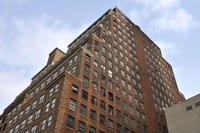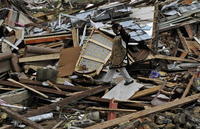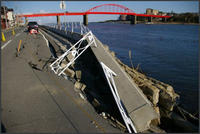-
Self-repairing composites repair cracks in coating of buildings, bridges
Researchers have developed vascularized structural composites, creating materials that are lightweight and strong with potential for self-healing, self-cooling, metamaterials, and more; these artificial microvascular systems can self-repair of materials damage, such as cracks in a coating applied to a building or bridge
-
-
Why the Twin Towers collapsed: new theory
Materials scientist says that a mixture of water from sprinkler systems and molten aluminum from melted aircraft hulls created explosions that led to the collapse of the Twin Towers on 9/11
-
-
Speeding skyscraper construction -- and making them stronger
Researchers are working on a new technique that could speed construction of skyscrapers while also providing enough stiffness and strength to withstand earthquakes and forces from high winds
-
-
Building codes may underestimate multiple hazard risks
Current building codes consider natural hazards individually — if earthquakes rank as the top threat in a particular area, local codes require buildings to withstand a specified seismic load; if hurricanes or tornadoes are the chief hazard, homes and buildings must be designed to resist loads up to an established maximum wind speed; engineers say that building codes should address multiple hazard scenarios
-
-
9/11 legacy: more resilient skyscrapers

Following the 9/11 attacks on the Twin Towers in New York, many predicted that the age of the skyscraper was over; there has been no slowdown in skyscraper orders, however — but the skyscrapers being built today are much stronger than the Twin Towers were; new materials, innovative designs, and attention to safety make today’s skyscraper much more resilient to man-made and natural disasters
-
-
Studying the effects of fire on steel structures, nuclear plants
Building fires may reach temperatures of 1,000 degrees Celsius, or more than 1,800 degrees Fahrenheit, and the strength of steel structures drops by about 40 percent when exposed to temperatures exceeding 500 degrees Celsius; scientists study precisely what happens to the connections between a floor’s steel beams and the building columns when these connections are exposed to intense heat
-
-
New York's older brick buildings vulnerable

To get a better idea of just how much damage even a moderate earthquake would cause to unreinforced masonry buildings, earthquae-engineering researchers are reconstructing brick walls like those in New York City buildings that are approximately 100 years old
-
-
Calls for more stringent standards in wake of increasing storm damage

Researchers from a team funded by the National Science Foundation have examined some of last spring’s massive tornado damage and conclude in a new report that more intensive engineering design and more rigorous, localized construction and inspection standards are needed to reduce property damage and loss of life
-
-
Improved engineering to protect structures on storm’s edge

In the wake of the horrendous tornadoes that delivered massive destruction to Alabama in April, University of Alabama engineers have analyzed building structures and design codes to recommend an approach to safer and stronger buildings going forward
-
-
Averting bridge disasters: new sensors could save hundreds of lives
One of every four U.S. highway bridges has known structural problems or exceeded its intended life-span. Most only get inspected once every one or two years; University of Maryland researcher has developed a new sensor that measures indicators of a bridge’s structural health, such as strain, vibration, flexibility, and development of metal cracks; the sensors are expected to last more than a decade, with each costing about $20
-
-
Earthquakes: scientists will shake 5-story building in Japan
Landmark earthquake engineering tests this summer in Japan could open the door for earthquake-proofing technology applied to hospitals, nuclear power plants, and emergency-response facilities to be more common in the United States, and confirm the capabilities for the technology used in Japan and the rest of the world
-
-
Bridge destruction to offer clues about 'fracture-critical' spans
A civil engineer at Purdue University is taking advantage of the demolition of a bridge spanning the Ohio River to learn more about how bridges collapse in efforts to reduce the annual cost of inspecting large spans
-
-
Studying the Japan quake's impact on soil will improve building design

The 11 March quake that hit Japan weakened subsurface materials by as much as 70 percent; that nonlinear response from the top layer of the Earth’s crust affected how the movement of faults deep beneath the surface was delivered to buildings, bridges, and other structures; understanding how the soil responds to powerful earthquakes could be important to engineers and architects designing future buildings to withstand the level of acceleration measured in this quake
-
-
Fire retardant shows promise -- if given space
Scientists have demonstrated that the more widely and uniformly dispersed nanoscale plates of clay are in a polymer, the more fire protection the nanocomposite material provides; when polymer — a type of polystyrene, used in packaging, insulation, plastic cutlery, and many other products — is imbued with nanometer scale plates of montmorillonite, the combination can create a material with unique properties or properties superior to those achievable by each component — clay or polymer — on its own
-
-
Quake-resistant superelastic alloy developed
Japanese scientists added a small amount of nickel to an iron-based alloy, and found that the new material can recover its original shape at any temperature from -196 to 240 degrees Celsius; the material may be used in environments that are constantly exposed to extreme temperatures, such as joints and controls in cars, planes, and spacecraft; it may also help buildings cushion stress and violent movement in earthquakes
-
- All
- Regional
- Water
- Biometrics
- Borders/Immig
- Business
- Cybersecurity
- Detection
- Disasters
- Government
- Infrastructure
- International
- Public health
- Public Safety
- Communication interoperabillity
- Emergency services
- Emergency medical services
- Fire
- First response
- IEDs
- Law Enforcement
- Law Enforcement Technology
- Military technology
- Nonlethal weapons
- Nuclear weapons
- Personal protection equipment
- Police
- Notification /alert systems
- Situational awareness
- Weapons systems
- Sci-Tech
- Sector Reports
- Surveillance
- Transportation
Advertising & Marketing: advertise@newswirepubs.com
Editorial: editor@newswirepubs.com
General: info@newswirepubs.com
2010-2011 © News Wire Publications, LLC News Wire Publications, LLC
220 Old Country Road | Suite 200 | Mineola | New York | 11501
Permissions and Policies
Editorial: editor@newswirepubs.com
General: info@newswirepubs.com
2010-2011 © News Wire Publications, LLC News Wire Publications, LLC
220 Old Country Road | Suite 200 | Mineola | New York | 11501
Permissions and Policies
